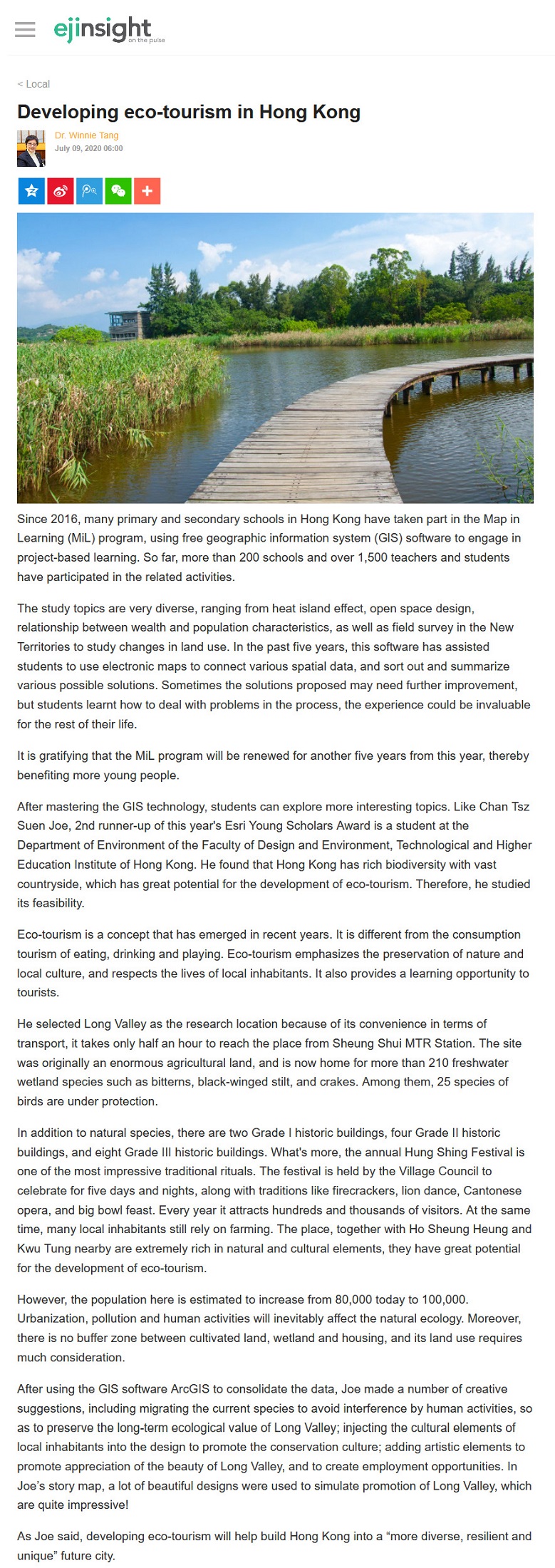網上版請按此

Developing eco-tourism in Hong Kong
Since 2016, many primary and secondary schools in Hong Kong have taken part in the Map in Learning (MiL) program, using free geographic information system (GlS) software to engage in project-based learning. So far, more than 200 schools and over 1,500 teachers and students have participated in the related activities.
The study topics are very diverse, ranging from heat island effect, open space design, relationship between wealth and population characteristics, as well as field survey in the New Territories to study changes in land use. In the past five years, this software has assisted students to use electronic maps to connect various spatial data, and sort out and summarize various possible solutions. Sometimes the solutions proposed may need further improvement, but students learnt how to deal with problems in the process, the experience could be invaluable for the rest of their life.
It is gratifying that the MiL program will be renewed for another five years from this year, thereby benefiting more young people.
After mastering the GIS technology, students can explore more interesting topics. Like Chan Tsz Suen Joe, 2nd runner-up of this year's Esri Young Scholars Award is a student at the Department of Environment of the Faculty of Design and Environment, Technological and Higher Education Institute of Hong Kong. He found that Hong Kong has rich biodiversity with vast countryside, which has great potential for the development of eco-tourism. Therefore, he studied its feasibility.
Eco-tourism is a concept that has emerged in recent years. It is different from the consumption tourism of eating, drinking and playing. Eco-tourism emphasizes the preservation of nature and local culture, and respects the lives of local inhabitants. It also provides a learning opportunity to tourists.
He selected Long Valley as the research location because of its convenience in terms of transport, it takes only half an hour to reach the place from Sheung Shui MTR Station. The site was originally an enormous agricultural land, and is now home for more than 210 freshwater wetland species such as bitterns, black-winged stilt, and crakes. Among them, 25 species of birds are under protection.
In addition to natural species, there are two Grade I historic buildings, four Grade II historic buildings, and eight Grade III historic buildings. What's more, the annual Hung Shing Festival is one of the most impressive traditional rituals. The festival is held by the Village Council to celebrate for five days and nights, along with traditions like firecrackers, lion dance, Cantonese opera, and big bowl feast. Every year it attracts hundreds and thousands of visitors. At the same time, many local inhabitants still rely on farming. The place, together with Ho Sheung Heung and Kwu Tung nearby are extremely rich in natural and cultural elements, they have great potential for the development of eco-tourism.
However, the population here is estimated to increase from 80,000 today to 100,000. Urbanization, pollution and human activities will inevitably affect the natural ecology. Moreover, there is no buffer zone between cultivated land, wetland and housing, and its land use requires much consideration.
After using the GlS software ArcGIS to consolidate the data, Joe made a number of creative suggestions, including migrating the current species to avoid interference by human activities, so as to preserve the long-term ecological value of Long Valley; injecting the cultural elements of local inhabitants into the design to promote the conservation culture; adding artistic elements to promote appreciation of the beauty of Long Valley, and to create employment opportunities. In Joe’s story map, a lot of beautiful designs were used to simulate promotion of Long Valley, which are quite impressive!
As Joe said, developing eco-tourism will help build Hong Kong into a "more diverse, resilient and unique" future city.
Dr. Winnie Tang
Adjunct Professor, Department of Computer Science, Faculty of Engineering; Department of Geography, Faculty of Social Sciences and Faculty of Architecture, The University of Hong Kong